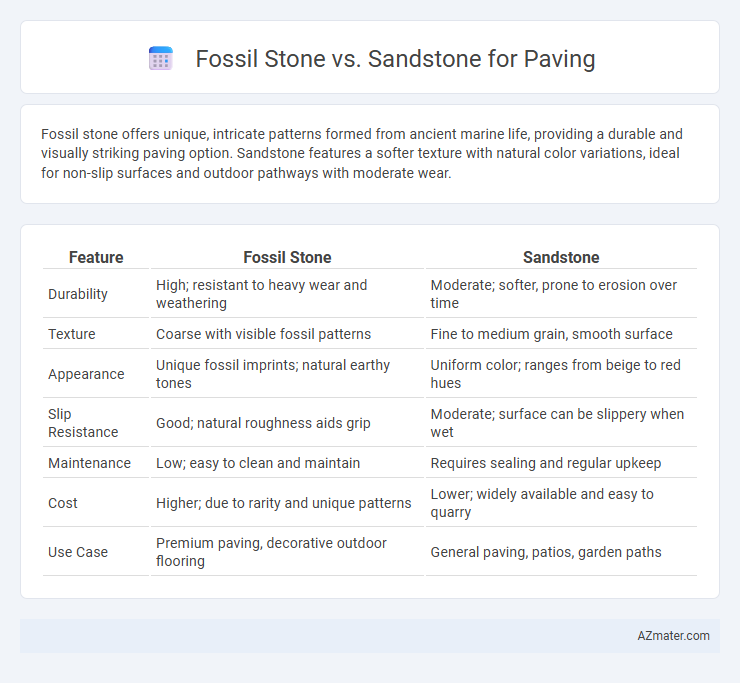Fossil stone offers unique, intricate patterns formed from ancient marine life, providing a durable and visually striking paving option. Sandstone features a softer texture with natural color variations, ideal for non-slip surfaces and outdoor pathways with moderate wear.
Table of Comparison
| Feature | Fossil Stone | Sandstone |
|---|---|---|
| Durability | High; resistant to heavy wear and weathering | Moderate; softer, prone to erosion over time |
| Texture | Coarse with visible fossil patterns | Fine to medium grain, smooth surface |
| Appearance | Unique fossil imprints; natural earthy tones | Uniform color; ranges from beige to red hues |
| Slip Resistance | Good; natural roughness aids grip | Moderate; surface can be slippery when wet |
| Maintenance | Low; easy to clean and maintain | Requires sealing and regular upkeep |
| Cost | Higher; due to rarity and unique patterns | Lower; widely available and easy to quarry |
| Use Case | Premium paving, decorative outdoor flooring | General paving, patios, garden paths |
Introduction to Fossil Stone and Sandstone
Fossil stone, a sedimentary rock embedded with prehistoric fossilized remains, offers unique textures and patterns ideal for decorative paving applications. Sandstone, composed primarily of compacted sand grains, provides a durable and naturally slip-resistant surface suitable for various outdoor paving projects. Both materials exhibit distinct aesthetic and structural properties that influence their selection based on design requirements and environmental conditions.
Understanding Fossil Stone: Composition and Features
Fossil stone, primarily composed of sedimentary limestone rich in fossilized marine life, exhibits a unique texture and natural patterns that add character to paving surfaces. Its high calcium carbonate content contributes to excellent durability and resistance to weathering, making it suitable for both indoor and outdoor applications. Fossil stone's polished finish enhances its aesthetic appeal while maintaining slip resistance, distinguishing it from the more uniformly granular and porous sandstone commonly used in paving.
Sandstone Overview: Characteristics and Varieties
Sandstone is a durable and versatile natural stone widely favored for paving due to its unique grainy texture and range of earthy colors, including reds, yellows, and browns. Its porosity offers good slip resistance, making it ideal for outdoor walkways and patios, while its variety spans from fine-grained quartz-rich to coarser grains with visible fossils. Popular varieties like Rainbow, Brown, and White Sandstone provide aesthetic flexibility, combining durability with natural beauty suitable for both traditional and contemporary paving designs.
Visual Appeal: Fossil Stone vs. Sandstone Aesthetics
Fossil stone showcases intricate, natural patterns with embedded ancient organic shapes, creating a unique and striking visual appeal ideal for distinctive paving projects. Sandstone offers a warm, earthy palette with smooth textures and consistent grain, lending a timeless and versatile aesthetic to outdoor surfaces. The choice between fossil stone and sandstone hinges on preference for bold, fossilized detail versus classic, subtle elegance in paving materials.
Durability and Longevity Comparison
Fossil stone offers superior durability compared to sandstone due to its denser composition and resistance to weathering, making it ideal for high-traffic paving applications. Sandstone, while aesthetically pleasing and easier to work with, tends to be more porous and susceptible to erosion and wear over time, reducing its longevity under heavy use. Choosing fossil stone for paving ensures a longer-lasting surface with minimal maintenance, outperforming sandstone in both lifespan and durability.
Slip Resistance and Safety for Paving
Fossil stone offers superior slip resistance due to its naturally textured surface, making it a safer choice for paving in wet or high-traffic areas. Sandstone, while aesthetically pleasing, tends to have a smoother finish that can become slippery when wet, requiring additional treatment for enhanced safety. Choosing fossil stone for paving projects ensures better traction and reduces the risk of slips and falls, crucial for both residential and commercial environments.
Maintenance Requirements: Ease of Care
Fossil stone requires minimal maintenance due to its natural durability and resistance to weathering, making it easy to clean with regular sweeping and occasional washing. Sandstone, while aesthetically pleasing, demands more upkeep as it is more porous and prone to staining, requiring sealing and periodic reapplication to protect against moisture and dirt. Choosing fossil stone over sandstone for paving reduces long-term care efforts and maintenance costs, ensuring a low-maintenance outdoor surface.
Environmental Impact and Sustainability
Fossil stone, derived from ancient marine deposits, often requires minimal processing, resulting in a lower carbon footprint compared to sandstone, which is quarried and shaped through energy-intensive methods. Sandstone extraction can lead to significant habitat disruption and water usage, whereas fossil stone's natural durability reduces the need for frequent replacement, enhancing long-term sustainability. Choosing fossil stone for paving supports eco-friendly practices by conserving natural resources and minimizing environmental degradation.
Cost Analysis: Pricing and Installation
Fossil stone generally commands higher prices per square foot compared to sandstone due to its unique patterns and rarity, with costs typically ranging from $15 to $30 versus sandstone's $10 to $20. Installation of fossil stone requires more skilled labor and specialized tools to preserve the intricate fossil imprints, increasing labor costs by approximately 20-30%. Sandstone offers easier cutting and handling, resulting in lower overall installation expenses and making it a cost-effective option for large-scale paving projects.
Best Applications: Choosing the Right Stone for Your Project
Fossil stone offers unique aesthetic appeal with its embedded ancient marine life patterns, making it ideal for decorative paving and upscale outdoor patios where visual impact is key. Sandstone provides superior durability and slip resistance, making it suitable for high-traffic walkways, garden paths, and pool surrounds that require functionality and safety. Selecting between fossil stone and sandstone depends on balancing decorative desires with practical needs based on the project's exposure and usage conditions.

Infographic: Fossil stone vs Sandstone for Paving
 azmater.com
azmater.com